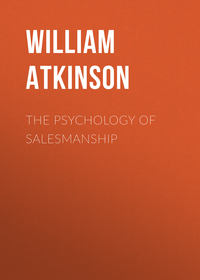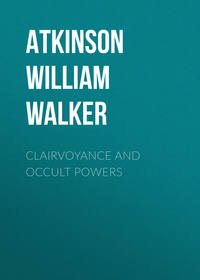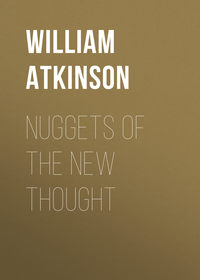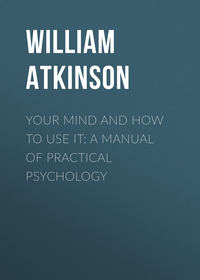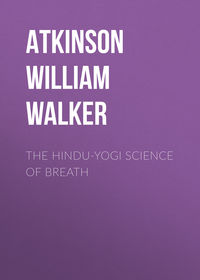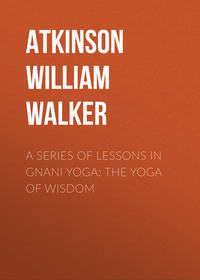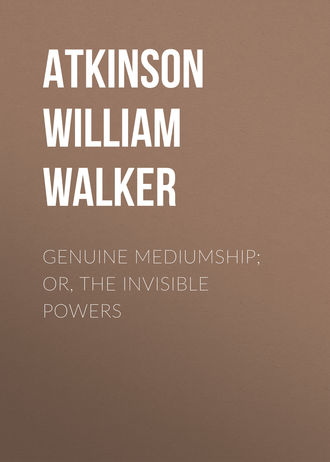 полная версия
полная версияGenuine Mediumship; or, The Invisible Powers
One writer says: "When you come in contact with people who are seeking to influence you by psychic methods, either direct or indirect, you will find yourself able to defy their mental attacks by simply remembering the strength immanent in your Ego, or Spirit, aided by the statement or affirmation (made silently to yourself) 'I am an Immortal Spirit, using the power of my Ego, which renders me immune from all base psychic attacks or power.' With this mental attitude you may make powerful even the slightest mental effort in the direction of sending forth your own mental vibrations, and these will scatter the adverse influences in all directions; it will often be found that the other person will show signs of confusion in such a case, and will seek to get away from your presence. With this consciousness held in mind, your mental command to another, 'Let me alone—I cast off your influence by the power of my Spirit,' will operate so strongly that you will often actually see the effect at once. If the other person be stubborn, and determined to influence you by words of suggestion, coaxing, threatening, or similar methods, look him or her straight in the eye, saying mentally: 'I defy you—my inner power casts off your influence.' Try this the next time that any one attempts to influence you either verbally or by means of thought-waves, and see how strong and positive you will feel, and how the efforts of the other person will fail. This sounds simple, but the little secret is worth thousands of dollars to every individual who will put it into practice."
Repelling Adverse Influences
This writer continues: "Not only in the case of personal influence in the actual presence of the other person may be defeated in this way, but the same method will act equally well in the matter of repelling the mental influence of others directed against you in the form of 'absent treatments,' etc. If you feel yourself inclining toward doing something which in your heart you feel is not to your best interests, judged from a true viewpoint, you may know that, consciously or unconsciously, someone is seeking in influence you in this way. Then smile to yourself, and make the statements mentioned above, or some similar one, and holding the power of the Spirit within your soul, send forth a mental command just as you would in case the person were actually before you in person. You may also deny out of existence the influencing power, by asserting mentally: 'I deny your power to influence me; you have no such power over me; I am resting securely upon the Spirit within me; I deny out of existence any power over me asserted by you.' After repelling these absent influences you will at once experience a feeling of relief and strength, and will be able to smile at the thought of any such adverse influence affecting you in the slightest."
Neutralizing Psychic Influences
Another writer gives us the following most interesting information and advice for use in cases of this kind: "I wish to point out to you a means of protection against the use of psychic influence against yourself on the part of unscrupulous persons, or any other persons whomsoever, for that matter. One is fully justified in employing this method of protection against even the meddling influence of other persons, who are trying to influence you without your permission or consent. The following is the method of self-protection or defense against this class of psychic influence: In the first place, you must, of course, refuse to admit to your mind any feeling of fear regarding the influence of other persons, for such fear opens the door to their influence, as all students of this subject know. If you have been, or are fearful of the psychic influence of any person, you must get to work and drive out that feeling by positive and vigorous denials. The denial, as all students know, is the positive neutralizer of the psychic influence of another person, providing you make it in full belief in its truth. You must take the mental position (which is really the true one) that you are absolutely immune to the psychic attack or influence. You should say, mentally, 'deny to any person the power to influence me psychically without my consent; I am positive to all such influences, and they are negative to me; I neutralize all such influences by this positive denial!' It should encourage you to know that it requires far less force and power to repel and neutralize psychic influences of this kind, than is required to send forth the power; an ounce of denial and protection overcomes a pound of psychic attacking power. Nature gives you the means of protection, and gives you the 'best end of the stick'; and it is your own fault if you do not use it effectively. A word to the wise is sufficient."
Telepathic Phenomena
The second general class of phenomena in the general category of Voluntary Transmission of Mental Vibrations is that known as "Telepathic Phenomena." In a sense, of course, all phases of Thought Transmission, and particularly that of Voluntary Thought Transmission, may be considered as forms of Telepathy; but for the purpose of classification and distinction we have in this book classed as Telepathic Phenomena merely those forms and phases of Thought Transference in which there is an agreement between the telepathic sender and the telepathic receiver, and in which the experiments are conducted more or less along the lines of scientific investigation.
Scientific Investigators
Scientific observers, for a number of years past, have been conducting careful series of experiments in Telepathy, and many volumes of the reports of such investigations have been published by various psychic research societies. Among the eminent scientists who have devoted much attention to this subject are the following: Professor Henry Sidgewick, of Cambridge University; Professor Balfour Stewart, of the Royal Society of England; Rt. Hon. A. J. Balfour, the eminent English statesman and scientist; Professor William James, the eminent American psychologist; Sir William Crookes, the great English chemist, physicist, who invented the celebrated "Crookes' Tubes," without which the discovery of the X-Rays, Radio Activity, etc., would have been impossible; Frederick W. H. Myers, the celebrated investigator of Psychic Phenomena; and Sir Oliver Lodge, the eminent English scientist. All these men are of the highest international standing and reputation, and their acceptance of the phenomena of Telepathy places the same on a firm scientific basis.
How Experiments Are Conducted
The scientific experiments involving Telepathy, which have been conducted by numerous societies for psychical research and other bodies, have ranged from quite simple tests to those very complex. In all of these experiments there has been one person called the "sender," and another called the "receiver"—or names corresponding to these. The sender fixes in his mind a strong impression of the name or picture to be transmitted, and then makes a positive effort of the will to transmit the same to the receiver. The receiver assumes a passive receptive mental attitude, and then reports the word or image that comes into his mind. The more complex tests embody these same simple features.
Some of the early reports of the Society for Psychical Research, of London, England, show results most amazing to those who have not made a personal investigation of these matters. In some of the tests, the receiver correctly reported seventeen cards in succession, the said cards having been shown the sender, but kept out of sight of the receiver, and no possible communication between the two being allowed. In tests of naming small objects held by the sender, the receiver correctly named five out of six. In one complicated test, in which various objects, names, etc., were transmitted, the report shows a successful report of 202 out of a possible 382. Such results, of course, took the results entirely out of the operation of the law of averages. Other successful experiments showed a high percentage of results obtained from the reproduction by the sender of geometrical and other figures and designs exhibited to the sender.
Private Experiments
But, after all, the most convincing evidences of Telepathy are those which most of us have met with in our own experience. There are but few intelligent, observing persons who have not, at some time in their life, had experiences of this kind, in which the thoughts of others were perceived plainly by themselves. Many persons have established such a close rapport condition between themselves and friends or relatives that instances of remarkable thought-transmission between them are quite common and ordinary.
Development of Telepathic Power
Practically every person may develop a certain degree of telepathic power, sending, receiving, or both, by means of a moderate amount of regular and earnest practice and experiments. In developing sending power, the person should cultivate concentration, and the use of the will in the direction of projecting mental states; in the case of the desired development of the receiving power, the person should develop receptiveness and passivity, and a certain recognition of an actual telepathic impulse which is impossible to describe in words but which comes to every investigator, and which when once experienced is always recognized thereafter.
"Mind Reading."
Perhaps the best plan for the beginner is to practice the popular "mind reading" experiment or game, which is quite popular in some localities, and among persons interested in this line of thought. The experiments of this kind are performed, generally, about as follows: The receiver leaves the room, and during his or her absence the company in the room select some object, large or small, such as a chair or a small penknife, etc., and the same is shown and named to the sender. Then the receiver is called back into the room for the experiment, and is blindfolded securely. Then the receiver takes the right hand of the sender and places it in his (the receiver's) left hand, holding it firmly there. The sender then concentrates his mind upon the object to be "found," and mentally wills that the receiver move toward it. The receiver then experiences a peculiar faint impulse in the direction of the object, and accordingly moves toward it. After considerable practice, the receiver acquires the faculty of not only finding large objects, but also is able to locate small objects, such as concealed rings, pins, etc.
Development Practices
This class of experiments, while open to the objection that there may be more or less muscular direction consciously or unconsciously given by the sender, nevertheless tend to develop proficiency in both sender and receiver. In fact, such experiments are perhaps one of the very best methods of developing projecting or receiving power along the lines of occult or psychic forces. This because the persons become familiar with the psychic processes involved, and their efficiency becomes increased by practice and experiment. This plan is like that of teaching a child how to walk by means of holding its hand, allowing it to rest on chairs, etc. In practicing such experiments, the receiver will soon become conscious of receiving the thought message in what may be called a "wireless flash," instead of by the slower, and less clear process of transmission through the physical body of the sender, and thence through his own nerves. When the sender begins to experience these flashes of consciousness, he is ready to proceed to the next stage.
The "Willing Game."
The second stage on telepathic development is much akin to that just described, with the difference that there is no physical contact between the sender and the receiver—no holding of hands, etc. A variation of this is found in the familiar "willing game" in which the whole roomful of persons concentrates upon the receiver, and "wills" that he find a selected object. On the whole, however, the private experiments conducted by the sender and the receiver, with perhaps a few intelligent and sympathetic spectators, are far better than the "willing game" plan, in which there are usually many triflers present ready to make a joke of the whole thing, and thus taking away that true concentration under which the best results may be obtained.
Formal Tests
The third step in telepathic development is that of conducting experiments similar to those originally conducted by the Society for Psychical Research, previously mentioned. That is to say, the sender may select cards from a pack, coins from a pile, small objects from a collection, etc., and then endeavor to transmit the impression of the same to the receiver—the latter then reporting his flashes of impression received. This may be rendered more complicated by having the sender in one place, and the receiver at another, the time having previously been agreed upon between them. In experiments conducted at long range, it has been generally found better for the receiver to write down the word, thought, or mental, picture which has been transmitted to him by the sender; and for the sender to write down the name or picture of the thing the idea of which he has transmitted. These memoranda serve not only as scientific proof of the experiment, but also serve as a barometer of progress being made during the experiments.
Automatic Writing
In this connection it may be stated that many investigators and experimentors along the lines of telepathic phenomena have met with considerable success in the direction of Automatic Writing from living persons, which of course is merely a special form of Telepathy. In some cases the communications received in this way were at first thought to be from disembodied entities, until later it was discovered that the thoughts were actually transmitted (in some cases unintentionally) by living persons. The late W. T. Stead, the London editor and famous investigator of psychic phenomena, who was lost on the "Titanic" several years ago, was remarkably successful along this special line of telepathic transmission, he being one of the most efficient receivers of this kind of which those familiar with the subject have any knowledge. His written records of these experiments are very interesting, and form a valuable contribution to this subject. In this class of experiments, the sender concentrates fixedly upon the thought—word for word—and wills that the recipient write down the word so transmitted; the receiver sit passively at the time agreed upon, and allows his arm and hand to be moved by means of the psychic currents beating upon him, and which are then unconsciously transformed into muscular action—the process being similar to that of ordinary writing, except that instead of the activity of the brain of the writer being behind the muscular motion, that of the sender performs that task.
Psychic Sensitiveness
The student of this book will find in the succeeding portions thereof, from time to time, certain general instructions regarding the cultivation of psychic receptivity and sensitiveness. These general instructions are also applicable to the cultivation of telepathic power, and may be properly applied to that end. There is really but one general principle involved in all the many forms of psychic receptivity, namely that of (1) shutting the senses to the ordinary impressions of the outside world, and (2) opening the higher channels of sense to the impressions coming in the form of vibrations of the higher forces and finer powers of Nature. At the last, it is simply a matter of "getting in tune," just as truly as in the case of the wireless telegraphy. These things are difficult to explain in ordinary words to one who has had no experience along these lines; but when one begins to actually experiment and practice, the way opens out gradually and steadily, and then the person can grasp the meaning of the little "hints" dropped by others who have traveled the same path. So, after all, it comes down to the matter of Practice, Experiment, and Learning by Trying!
PART IV
CLAIRVOYANCE AND KINDRED PHENOMENA
A very large and very interesting class of occult or psychic phenomena is that known under the very general classification of "Clairvoyance," which term we have thought it advisable to employ in this sense in this book, notwithstanding the technical objections urged by some against such a general usage. The term "Clairvoyance" really means "clear seeing," or "clear sight," but its special meaning, established by long usage, is "A power of discerning objects not perceptible to the normal senses." When it comes to the technical use of the term by students and teachers of psychic research and occultism, however, there is found a confused meaning of the term, some employing it in one sense, and others in another one. Accordingly, it is perhaps as well to explain the particular usage adopted and followed in this book.
Clairvoyance Defined
The English Society for Psychical Research, in its glossary, defines the term as follows: "The faculty or act of perceiving, as though visually, with some coincidental truth, some distant scene; it is used sometimes, but hardly properly, for transcendental vision, or the perception of beings regarded as on another plane of existence." A distinguished investigator along psychic lines, in one of her reports to the English Society for Psychical Research, has given the following definition of this term as employed by her in her reports, viz., "The word 'clairvoyant' is often used very loosely, and with widely different meanings. I denote by it a faculty of acquiring supernormally, but not by reading the minds of persons present, a knowledge of facts such as we normally acquire by the use of our senses. I do not limit it to knowledge that would normally be acquired by the sense of sight, nor do I limit it to a knowledge of present facts. A similar knowledge of the past, and if necessary, of future events, may be included. On the other hand, I exclude the mere faculty of seeing apparitions, which is sometimes called clairvoyance."
The last stated definition agrees almost perfectly with the views of the writer of the present book, and the term "Clairvoyance" is used here in the particular sense indicated by such definition. The student of this book, therefore, is asked to distinguish Clairvoyance, on the one hand, from the phenomena of Telepathy or Thought Transference, and, on the other hand, from the phenomena of communication with entities on other planes of existence, including the perception of apparitions.
The Phenomena of Clairvoyance
The phenomena of Clairvoyance may be subdivided (a) according to methods employed, and also (b) according to general distinctions. The said classifications follow:
Classification According to Methods. The classification of Clairvoyant Phenomena according to methods employed, proceeds as follows: (1) Psychometry, in which the clairvoyant becomes en rapport through the medium of some physical object connected with the person or scene which is the object of the en rapport connection; (2) Crystal Gazing, etc., in which the en rapport connection is established by means of a crystal, magic mirror, etc., into which the clairvoyant gazes; (3) Direct Clairvoyance, in which the clairvoyant directly establishes the en rapport connection by means of raising his or her psychic vibrations so as to become "in tune" with the finer vibrations of Nature, without the aid of physical objects.
Classification According to General Distinctions
The classification of Clairvoyant Phenomena according to general distinctions, proceeds as follows: (1) Present Clairvoyance, in which the objects perceived by the clairvoyant are present in Space and Time, although invisible to normal sight; (2) Space Clairvoyance, in which the clairvoyant vision includes objects and scenes removed in space from the immediate normal perception of the clairvoyant; (3) Time Clairvoyance, in which the clairvoyant perceives objects or scenes removed from him in past time, or future time.
In order that the student may obtain a comprehensive understanding of the phenomena of Clairvoyance, we have thought it well to give you a brief, general outline of the particular phenomena fitting into these several classes, and to give you, also, a general idea of the principal methods employed to obtain the phenomenal manifestations in question. We begin by calling your attention to the three general classes of method employed to obtain the manifestation of clairvoyant phenomena, namely: Psychometry, Crystal Gazing, and Clairvoyant Psychic States, respectively.
Psychometry
In Psychometry, the clairvoyant establishes the en rapport connection with objects, persons or scenes, removed in space or in time, by means of some physical object associated with the distant object, person or scene; for instance, the physical objects may be a piece of clothing, a bit of stone, a coin, a bit of jewelry, etc., which has been closely associated with that which the clairvoyant desires to sense psychically. The distinctive feature of this class of clairvoyant phenomena is this connecting link of physical objects. A writer has cleverly compared this connecting link with the bit of clothing which the keen-scented bloodhound is given to sniff in order that he may then discover by scent the person sought, the latter having previously worn the bit of clothing presented to the dog's sense of smell.
The "Psychic Scent."
Occultists have elaborated a technical theory to account for the phenomena of Psychometry, or rather to account for the action of the "connecting link" of the physical object employed to establish the connection between clairvoyant and distant object, person, or scene. But we do not think it advisable to enter into a discussion of these elaborate, technical theories, which are apt to confuse the beginner, and to distract his attention from the important facts of the case. We think it is sufficient to say that the "connecting link," or physical object, seems to carry along with it, in its inner substance or nature, the vibrations of its past environment; and that the clairvoyant, coming into receptive contact with such vibrations, is enabled with comparative ease to follow up the psychic "scent" until he establishes clairvoyant en rapport connection with the distant object, person, or scene associated with the physical object. When it is remembered that the physical "scent" of anything is merely a matter of the detection of certain vibrations, the illustration is seen to be not so very far out of the way after all.
Magnetic Affinity
A somewhat celebrated investigator of psychic and occult phenomena has said concerning this phases of Clairvoyance: "The untrained clairvoyant usually cannot find any particular astral picture when it is wanted, without some special link to put him en rapport with the subject required. Psychometry is an instance in point. It seems as though there were a sort of magnetic attachment or affinity between any particle of matter and the record which contains its history—an affinity which enables it to act as a kind of conductor between that record and the faculties of anyone who can read it. For instance, I once brought from Stonehenge a tiny fragment of stone, not larger than a pin's head, and on putting this into an envelope and handing it to a psychometrist who had no idea what it was, she at once began to describe that wonderful ruin and the desolate country surrounding it, and then went on to picture vividly what were evidently scenes from its early history, showing that the infinitesimal fragment had been sufficient to put her into communication with the records connected with the spot from which it came. The scenes through which we pass in the course of our life seem to act in the same way upon the cells of our brain as did the history of Stonehenge upon that particle of stone. They establish a connection with those cells by means of which our mind is put en rapport with that particular portion of the records, and so we 'remember' what we have seen."




